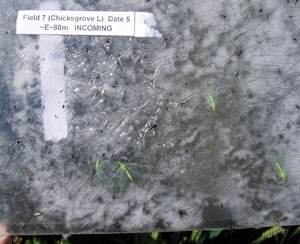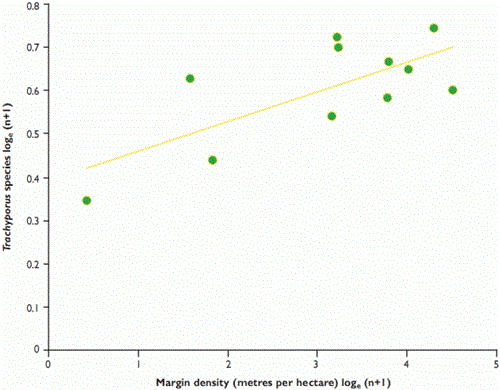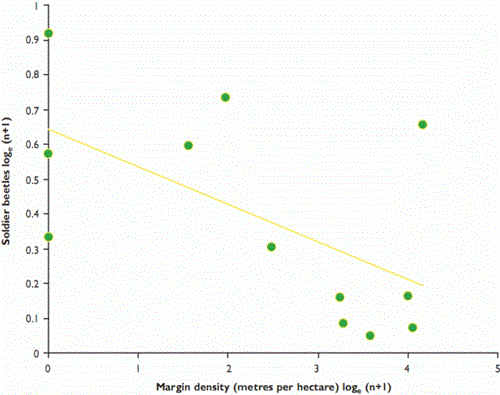 In the re-bugging the system project we demonstrated that winter wheat fields with field margins contained higher numbers of some aerially-dispersing aphid predators such as money spiders, soldier beetles and Tachyporus species (aphid-eating rove beetles). However, as these predators are likely to disperse over large distances, studies of single fields may be inappropriate. Consequently we decided to look at this at a landscape scale.
In the re-bugging the system project we demonstrated that winter wheat fields with field margins contained higher numbers of some aerially-dispersing aphid predators such as money spiders, soldier beetles and Tachyporus species (aphid-eating rove beetles). However, as these predators are likely to disperse over large distances, studies of single fields may be inappropriate. Consequently we decided to look at this at a landscape scale.
Figure 1: Number of Tachyporus species found in 11 winter wheat fields in relation to surrounding field margin density within a 750-metre radius
r2 adjusted = 0.46; P = 0.013

In our landscape scale study, we trapped insects on sticky traps in 12 winter wheat fields and mapped the field margins within a 750-metre radius of each field. The numbers of Tachyporus species increased with the total length of field margin per hectare within a 750-metre radius (see Figure 1). Tachyporus species typically over-winter in field margins and move into the fields in spring, so the additional field margin habitat appears to improve their numbers in winter wheat fields. However, soldier beetles in wheat fields showed a negative response to local field margin density at a 50-metre radius, so where there were more margins there were fewer soldier beetles found in the field (see Figure 2). The field margins may be drawing in and holding soldier beetles, or they may forage in margins where prey are likely to be more abundant than in the crop.
Figure 2: Number of soldier beetles found in 12 winter wheat fields in relation to surrounding field margin density within a 50-metre radius
r2 adjusted = 0.29; P = 0.041

Acknowledgements
We would like to thank all the farmers who helped with these studies. The re-bugging the system project was funded through the Research Councils UK Rural Economy and Land Use programme.
Further reading
- Oaten, H., Holland, J.M. & Smith, B.M. (2007). Attack from above: The effect of field margins on movements of aerially dispersing aphid predators. Aspects of Applied Biology 83, Crop Protection in Southern Britain, 89-93.
- Oaten, H., Holland, J.M., Smith, B. & Leather, S. (2008). Does the spatial density of field margins affect aerially dispersing aphid predators, if so at what scale? In: W.A.H Rossing, L., H-M. Poehling & M. Van Helden (Eds), Landscape management for functional biodiversity. IOBC/WPRS Bulletin 34, 73-76.